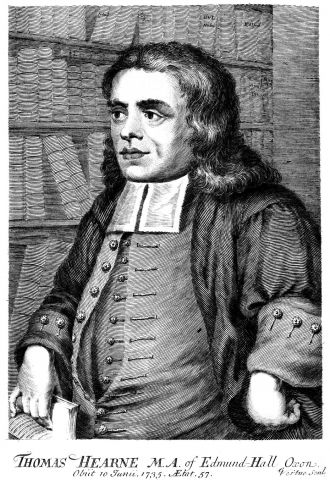1733 - Hearne, Thomas - Note in Chronicon Prioratus de Dunstaple
| Allusion | |
|---|---|
| Date | 1733 |
| Author | Hearne, Thomas |
| Title | Note in Chronicon sive Annales Prioratus de Dunstaple |
| Mentions | Robin Hood; Robin Hood's Bower [Maidenhead] |

By Henrik Thiil Nielsen, 2018-05-29. Revised by Henrik Thiil Nielsen, 2022-12-03.
Allusion
[Joseph Ritson's translation:]
Certainly Silchester, in Hampshire, signifies nothing but the city of flints (that is, a city composed or built of flint-stones). [. . .] And what is more, in that very Chiltern country you may frequently see houses built of flints, in erecting which, in ancient times, I suppose that many persons involved themselves deeply in debt, and that, in order to extricate themselves, they took up money at interest of I know not what great men, which so far disturbed their minds that they would become thieves, and do many things in no wise agreeable to the English government. Hence, the nobility ordered that large woods in the Chiltern country should, in a great measure, be cut down, lest they should conceal any considerable body of robbers, who were wont to convert the same into lurking places. [. . .] It concerns this matter to call to mind, that of this sort of robbers was that Robin or Robert Hood, of whom the vulgar dayly [sic] sing so many wonderful things. He (being now made an outlaw) before he retired into the north parts, frequently robing [sic] in the Chiltern country, linked[1] [sic] in the thickets thereof on purpose that he should not be taken. Thence it was, that to us boys, (exhilarating, according to custom, the mind with sports) certain countrymen, with whom we [vol. I, p. cii n.:] had accidentally some conversation, shewed us that sort of den or retreat (vulgarly called Robin Hoods bower) in Maydenhead-thicket: which thicket is the same that Leland in his Itinerary, called Frith, by which name the Anglo-Saxons themselves spoke of thickets. For although frið in reality signifys [sic] peace, yet since numerous groves with them (as well as before with the Britons) were deemed sacred, it is by no means to be wondered at that a great wood (because manifestly an asylum) should in the judgment of the Anglo-Saxons be called by no other name than friðer: [sic] and that Maydenhead-thicket was esteemed among the greater woods Leland himself is a witness. Rightly therefor [sic] did Robin Hood (as frið-bena) reckon himself to abide there in security.[2]
Source notes
The note in Hearne's edition is in italic type, ordinary type being used for emphasis. IRHB has reversed this. Where Hearne has black-letter, IRHB has bold type. Where Ritson uses the Old English alphabet, IRHB uses small-caps. IRHB's brackets, including ellipses where Ritson silently omits a passage.
IRHB comments
Ritson finds that "[w]hat he means by all this is, doubtless, sufficiently obscure: the mere name, however, of Robin Hoods bower seems a very feeble authority for concluding that gallant outlaw to have robed [sic] or skulked in the Chiltern hundreds".[3] Hearne certainly would not be the last writer to let fond memories of a childhood greenwood influence his speculations on the origins of Robin Hood. As he was born in 1678, we can draw the somewhat conservative conclusion that the name 'Robin Hood's Bower' was already applied to the small earthwork in Maidenhead thicket around 1690. The full names of the antiquarians to whom Hearne refers are John Leland and William Somner.
Lists
- Not included in Dobson, R. B., ed.; Taylor, J., ed. Rymes of Robyn Hood: an Introduction to the English Outlaw (London, 1976), pp. 293-11.
- Outside scope of Sussex, Lucy, compil. 'References to Robin Hood up to 1600', in: Knight, Stephen. Robin Hood: A Complete Study of the English Outlaw (Oxford, UK; Cambridge, Massachusetts: Blackwell, 1994), pp. 262-88.
Sources
- [Morins, Richard de]; Hearne, Thomas, ed. Chronicon sive Annales Prioratus de Dunstaple (Oxford, 1733), vol. I, p. 387 n. (contd. vol. I, pp. 388 n-389 n).
- [Ritson, Joseph, ed.] Robin Hood: A Collection of All the Ancient Poems, Songs, and Ballads, now Extant, Relative to that Celebrated English Outlaw, to Which are Prefixed Historical Anecdotes of His Life (London, 1795), vol. I, p. ci n. † (contd. vol. I, p. cii n.)
Background
- Wikipedia: John Leland (antiquary)
- Wikipedia: Thomas Hearne (antiquarian)
- Wikipedia: William Somner.
Discussion
- Dobson, R. B., ed.; Taylor, J., ed. Rymes of Robyn Hood: an Introduction to the English Outlaw (London, 1976), p. 295, s.n. Robin Hood's Arbour.
Also see
- Robin Hood's Arbour (Maidenhead)
- 1535 - Leland, John - Itinerary (1)
- 1535 - Leland, John - Itinerary (2)
- 1535 - Leland, John - Itinerary (4)
- 1540 - Leland, John - Collectanea.
Notes
- ↑ Read: lurked.
- ↑ [Morins, Richard de]; Hearne, Thomas, ed. Chronicon sive Annales Prioratus de Dunstaple (Oxford, 1733), vol. I, p. 387 n. (contd. vol. I, pp. 388 n.-389 n.); [Ritson, Joseph, ed.] Robin Hood: A Collection of All the Ancient Poems, Songs, and Ballads, now Extant, Relative to that Celebrated English Outlaw, to Which are Prefixed Historical Anecdotes of His Life (London, 1795), vol. I, p. ci n. † (contd. vol. I, p. cii n.)
- ↑ [Ritson, Joseph, ed.] Robin Hood: A Collection of All the Ancient Poems, Songs, and Ballads, now Extant, Relative to that Celebrated English Outlaw, to Which are Prefixed Historical Anecdotes of His Life (London, 1795), vol. I, p. cii n. Ritson's italics; IRHB's brackets.
